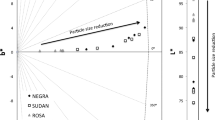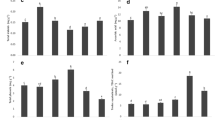Abstract
Roselle is a plant that accumulates anthocyanins significantly, hence its importance as food coloring and as a source of antioxidant compounds for human health. This study was aimed to determine phenolic composition and antioxidant capacity of methanolic extracts, and beverages obtained from native roselle cultivars in Mexico (Negra, Sudan, Rosa and Blanca) with different degrees of pigmentation, and to establish the color-composition relationship. Chromatographic methods were used to determine phenolic compounds: flavanols, flavonols, benzoic, hibiscus and phenolic acids as well as two main anthocyanins (cyanidin 3-sambubioside and delphinidin 3-sambubioside). The antioxidant capacity was evaluated by ABTS and FRAP assays. Tristimulus colorimetry showed to be a useful technique to determine the color-composition relationship, leading to equations that allowed to predict anthocyanin content of roselle (R > 0.84). Also, a stepwise linear discriminant analysis (SLDA) was developed in order to classify roselle cultivars. The obtained mathematical model could be an important tool to be used in colorimetric characterization of functional compounds used in food processing.


Similar content being viewed by others
Abbreviations
- DIA:
-
digital image analysis
- Dp3Sa:
-
delphinidin-3-sambubioside
- Cy3Sa:
-
cyanidin-3-sambubioside
- LDA:
-
linear discriminant analysis
- SLDA:
-
stepwise linear discriminant analysis
- TA:
-
total anthocyanins
References
Christian KR, Jackson JC (2009) Changes in total phenolic and monomeric anthocyanin composition and antioxidant activity of three varieties of sorrel (Hibiscus sabdariffa) during maturity. J Food Comp Anal 22(7–8):663–667
Mohd-Esa N, Hern FS, Ismail A, Yee CL (2010) Antioxidant activity in different parts of roselle (Hibiscus sabdariffa L.) extracts and potential exploitation of the seeds. Food Chem 122(4):1055–1060
Gomes Maganha E, da Costa Halmenschlager R, Moreira Rosa R, Pegas Henriques JA, Lia de Paula Ramos AL, Saffi J (2010) Pharmacological evidences for the extracts and secondary metabolites from plants of the genus Hibiscus. Food Chem 118(1):1–10
Wang J, Cao X, Jiang H, Qi Y, Chin KL, Yue Y (2014) Antioxidant activity of leaf extracts from different Hibiscus sabdariffa accessions and simultaneous determination of five major antioxidant compounds by LC-QTOF-MS. Molecules 19:21226–21238
Camelo-Méndez GA, Ragazzo-Sánchez JA, Jiménez-Aparicio AR, Vanegas-Espinoza PE, Paredes-López O, Del Villar-Martínez AA (2013) Comparative study of anthocyanin and volatile compounds content of four varieties of Mexican roselle (Hibiscus sabdariffa L.) by multivariable analysis. Plant Foods Hum Nutr 68(3):229–234
Sáyago-Ayerdi SG, Arranz S, Serrano J, Goñi I (2007) Dietary fiber content and associated antioxidant compounds in roselle flower (Hibiscus sabdariffa L.) beverage. J Agric Food Chem 55(19):7886–7890
Jara-Palacios MJ, Hernanz D, González-Manzano S, Santos-Buelga C, Escudero-Gilete ML, Heredia FJ (2014) Detailed phenolic composition of white grape by-products by RRLC/MS and measurement of the antioxidant activity. Talanta 125:51–57
Ivanova V, Stefova M, Vojnoski B, Dörnyei A, Márk L, Dimovska V, Stafilov T, Kilár F (2011) Identification of polyphenolic compounds in red and white grape varieties grown in R. Macedonia and changes of their content during ripening. Food Res Int 44(9):2851–2860
Benzie IFF, Strain JJ (1996) The ferric reducing ability of plasma (FRAP) as a measure of “antioxidant power”: the FRAP assay. Anal Biochem 239(1):70–76
Re R, Pellegrini N, Proteggente A, Pannala A, Yang M, Rice-Evans C (1999) Antioxidant activity applying an improved ABTS radical cation decolorization assay. Free Radic Biol Med 26:1231–1237
Rodríguez-Pulido FJ, Ferrer-Gallego R, González-Miret ML, Rivas-Gonzalo JC, Escribano-Bailon MT, Heredia FJ (2012) Preliminary study to determine the phenolic maturity stage of grape seeds by computer vision. Anal Chim Acta 732:78–82
Rodríguez-Pulido FJ, Gordillo B, González-Miret ML, Heredia FJ (2013) Analysis of food appearance properties by computer vision applying ellipsoids to colour data. Comput Electron Agric 99:108–115
Stinco CM, Rodríguez-Pulido FJ, Escudero-Gilete ML, Gordillo B, Vicario IM, Meléndez-Martínez AJ (2013) Lycopene isomers in fresh and processed tomato products: correlations with instrumental color measurements by digital image analysis and spectroradiometry. Food Res Int 50(1):111–120
Heredia FJ, Gonzalez-Miret ML, Álvarez C, Ramírez A (2006) DigiFood® Análisis de imagen (Software). Sevilla, Spain. Registro P.I. No. SE-01298
Fernández-Arroyo S, Rodríguez-Medina IC, Beltrán-Debón R, Pasini F, Joven J, Micol V (2011) Quantification of the polyphenolic fraction and in vitro antioxidant and in vivo anti-hyperlipemic activities of Hibiscus sabdariffa aqueous extract. Food Res Int 44:1490–1495
Herranz-López M, Fernández-Arroyo S, Pérez-Sánchez A, Barrajón-Catalán E, Beltrán-Debón R, Menéndez JA, Alonso-Villaverde C, Segura-Carretero A, Joven J, Micol V (2012) Synergism of plant-derived polyphenols in adipogenesis: perspectives and implications. Phytomedicine 19(3–4):253–261
Ramírez-Rodrigues MM, Plaza ML, Azeredo A, Balaban MO, Marshall MR (2012) Phytochemical, sensory attributes and aroma stability of dense phase carbon dioxide processed Hibiscus sabdariffa beverage during storage. Food Chem 134(3):1425–1431
Sreelatha S, Padma PR (2009) Antioxidant activity and total phenolic content of Moringa oleifera leaves in two stages of maturity. Plant Foods Hum Nutr 64(4):303–311
Torres-Morán MI, Escoto-Delgadillo ME, Ron-Parra J, Parra-Tovar G, Mena-Munguía S, Rodríguez-García A (2011) Relationships among twelve genotypes of roselle (Hibiscus sabdariffa L.) cultivated in western Mexico. Ind Crop Prod 34(1):1079–1083
Acknowledgments
Authors thank to Colegio Superior de Agricultura del Estado de Guerrero (CSAEGRO) and Quintín Obispo González for biological samples. Camelo-Méndez G.A also acknowledges to CONACYT-Mexico and SIP-IPN scholarships.
Author information
Authors and Affiliations
Corresponding author
Ethics declarations
Conflict of Interest
The authors confirm that this article content has no conflict of interest.
Electronic supplementary material
Below is the link to the electronic supplementary material.
Online Resource 1
(PDF 83 kb)
Online Resource 2
(PDF 170 kb)
Online Resource 3
(PDF 38 kb)
Rights and permissions
About this article
Cite this article
Camelo-Méndez, G.A., Jara-Palacios, M.J., Escudero-Gilete, M.L. et al. Comparative Study of Phenolic Profile, Antioxidant Capacity, and Color-composition Relation of Roselle Cultivars with Contrasting Pigmentation. Plant Foods Hum Nutr 71, 109–114 (2016). https://doi.org/10.1007/s11130-015-0522-5
Published:
Issue Date:
DOI: https://doi.org/10.1007/s11130-015-0522-5




